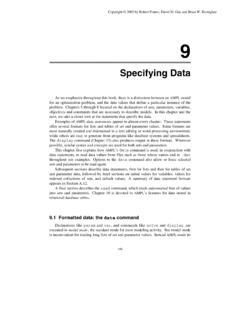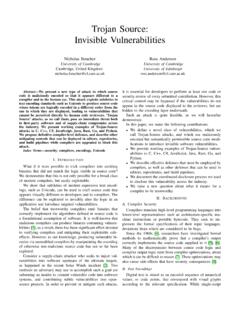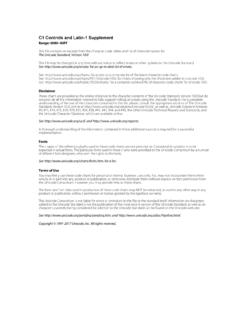Transcription of AMPL Reference Manual
1 A_____AMPL Reference ManualAMPLis a language for algebraic modeling and mathematical programming: a computer-readable language for expressing optimization problems such as linear programming in algebraicnotation. This appendix summarizes the features ofAMPL, with particular emphasis on technicaldetails not fully covered in the preceding chapters. Nevertheless, not every feature, construct, andoption is listed; theAMPLweb the most up to date and following notational conventions are used. Literal text is printed inconstant widthfont, while syntactic categories are printed initalic or subphrases enclosed inslanted square brackets[and]are optional, as are constructs with the Lexical rulesAMPL models involve variables, constraints, and objectives, expressed with the help of sets andparameters.
2 These are calledmodel model entity has an alphanumeric name: a stringof one or more UnicodeUTF-8letters, digits, and underscores, in a pattern that cannot be mistakenfor a numeric constant. Upper-case letters are distinct from lower-case constants are written in standard scientific notation: an optional sign, a sequence ofdigits that may contain a decimal point, and an optional exponent field that begins with one of thelettersd,D,eorE, as All arithmetic inAMPLis in the same precision (double pre-cision on most machines), so all exponent notations are are strings delimited either by single quotes or by double quotes"; the delimitingcharacter must be doubled if it appears within the literal, as in x y , which is a literal contain-ing the three charactersx y.
3 Newline characters may appear within a literal only if preceded by\.The choice of delimiter is arbitrary; abc and"abc"denote the same are distinct from numeric constants:1and 1 are is free form; white space (any sequence of space, tab or newline characters) may appearbetween any tokens. Each statement ends with a begin with#and extend to the end of the current line, or are delimited by/*and*/, in which case they may extend across several lines and do not nest. Comments may appearanywhere in declarations, commands, and words are reserved, and may not be used in other contexts:453454 AMPL Reference Manual APPENDIX ACurrent complements integer solve_result_numIN contains less suffixINOUT default logical sumInfinity dimen max symbolicInitial div min tableLOCAL else option thenOUT environ setof unionall exists shell_exitcode untilbinary forall solve_exitcode whileby if solve_message withincheck in solve_resultWords beginning with underscore are also
4 Reserved. The other keywords, function names, etc.,are predefined, but their meanings can be redefined. For example, the wordprodis predefined asa product operator analogous tosum, but it can be redefined in a declaration, such asset prod; # productsOnce a word has been redefined, the original meaning is synonyms for several keywords and operators; the preferred forms are on theleft. **= ==<> !=and &¬ !or ||prod Set membersA set contains zero or more elements or members, each of which is an ordered list of one ormore components. Each member of a set must be distinct. All members must have the same num-ber of components; this common number is called the set s literal set is written as a comma-separated list of members, between braces{and}.
5 If theset is one-dimensional, the members are simply numeric constants or literal strings, or any expres-sions that evaluate to numbers or strings:{"a","b","c"}{1,2,3,4,5,6,7,8,9} {t,t+1,t+2}For a multidimensional set, each member must be written as a parenthesized comma-separated listof the above:{("a",2),("a",3),("b",5)}{(1,2,3), (1,2,4),(1,2,5),(1,3,7),(1,4,6)}The value of a numeric member is the result of rounding its decimal representation to a floating-point number. Numeric members that appear different but round to the same floating-point num-ber, such , are considered the Indexing expressions and subscriptsMost entities inAMPLcan be defined in collections indexed over a set; individual items areselected by appending a bracketed subscript to the name of the entity.
6 The range of possible sub-scripts is indicated by anindexing expressionin the entity s declaration. Reduction operators, suchassum, also use indexing expressions to specify sets over which operations are subscript is a list of symbolic or numeric expressions, separated by commas and enclosed insquare brackets, as insupply[i]andcost[j,p[k]+1,"O+"]. Each subscripting expressionmust evaluate to a number or a literal. The resulting value or sequence of values must give a mem-ber of a relevant one-dimensional or multidimensional indexing indexing expression is a comma-separated list of set expressions, followed optionally by acolon and a logical such that expression, all enclosed in braces:indexing:{sexpr - list}{sexpr - list:lexpr}sexpr - list:sexprdummy - memberinsexprsexpr - list,sexprEach set expression may be preceded by a dummy member and the keywordin.
7 A dummy mem-ber for a one-dimensional set is an unbound name, that is, a name not currently defined. A dummymember for a multidimensional set is a comma-separated list, enclosed in parentheses, of expres-sions or unbound names; the list must include at least one unbound dummy member introduces one or more dummy indices (the unbound names in its compo-nents), whosescopes, or ranges of definition, begin just after the followingsexpr; an index s scoperuns through the rest of the indexing expression, to the end of the declaration using the indexingexpression, or to the end of the operand that uses the indexing expression. When a dummy mem-ber has one or more expression components, the dummy indices in the dummy member range overasliceof the set, , they assume all values for which the dummy member is in the set.
8 {A} # a set{A, B} # all pairs, one from A, one from B{i in A, j in B} # the same{i in A, B} # the same{i in A, C[i]} # all pairs, one from A, one from C[i]{i in A, (j,k) in D} # 1 from A and 1 (itself a pair) from D{i in A: p[i] > 0} # all i in A such that p[i] is positive{i in A, j in C[i]: i <= j} # i and j must be numeric{i in A, (i,j) in D: i <= j} # all pairs with i in A and i,j in D# (same value of i) and i <= jThe optional:lexprin an indexing expression selects only the members that satisfy the logicalexpression and excludes the others. Thelexprtypically involves one or more dummy indices ofthe indexing ExpressionsVarious items can be combined inAMPL s arithmetic and logical expressions.
9 An expressionthat may not contain variables is denotedcexprand is sometimes called a constant expression ,456 AMPL Reference Manual APPENDIX A_____Precedence Name Type Remarks1if-then-elseA, S A: if noelse, then else 0 assumedS: elsesexpr required2or ||L3exists forallL logical reduction operators4and &&L5< <= = == <> != >= >L6in not inL membership in set6within not withinLS within Tmeans setS setT7not !L logical negation8union diff symdiffSsymdiff symmetric difference9interS set intersection10crossS cross or Cartesian product11setof .. byS set constructors12+ - lessAalessb max (a b, 0 )13sum prod min maxA arithmetic reduction operators14* / div modAdiv truncated quotient of integers15+ -A unary plus, unary minus16 **A exponentiationOperators are listed in increasing precedence order.
10 Exponentiation andif-then-elseare right-associative; the other operators are left-associative. The Type col-umn indicates result types: A for arithmetic, L for logical, S for A-1:Arithmetic, logical and set though it may involve dummy indices. A logical expression, denotedlexpr, may not containvariables when it is part of acexpr. Set expressions are A-1 summarizes the arithmetic, logical and set operators; the type column indicateswhether the operator produces an arithmetic value (A), a logical value (L), or a set value (S).Arithmetic expressions are formed from the usual arithmetic operators, built-in functions, andarithmetic reduction operators likesum:expr:numbervariableexpr arith - op expr arith - opis+ - less * / mod div **unary - op expr unary - opis+ -built - in(exprlist)iflexprthenexpr [elseexpr ]reduction - op indexing expr reduction - opissum prod max min(expr)Built-in functions are listed in Table arithmetic reduction operators are used in expressions likesum {i in Prod} cost[i] * Make[i]The scope of theindexingexpression extends to the end of theexpr.








